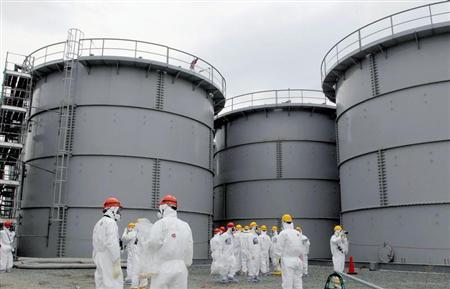Operator of wrecked Japan nuclear plant pledges improvements
Date: 16-Oct-13
Country: JAPAN
Author: Mari Saito and Yoshifumi Takemoto

Tanks of radiation-contaminated water are seen at the Tokyo Electric
Power Co (TEPCO)'s tsunami-crippled Fukushima Daiichi nuclear power
plant in Fukushima prefecture, in this photo released by Kyodo March
1, 2013.
Photo: Kyodo
The operator of Japan's wrecked Fukushima nuclear plant, under fire to put right repeated contamination mishaps, promised on Tuesday to draft in extra workers and improve equipment as part of plans to make the site safe and keep the company solvent.
Tokyo Electric Power Company, or Tepco, has been reprimanded twice in as many months by Japan's nuclear regulator for mismanagement in a cleanup operation more than 2 1/2 years after the Fukushima Daiichi plant was struck by an earthquake and tsunami.
Though the company has posted more than $27 billion in net losses since the disaster, it has received pledges of financing from banks totalling $5.9 billion.
Much of that, however, is contingent on Tepco securing the regulator's approval to restart two of seven reactors at another of its plants, the world's largest nuclear plant.
"We will increase the workforce at Fukushima Daiichi nuclear power plant ... and make sure we have an accurate grasp of the situation, follow procedures, introduce proper communications and instructions needed to carry out competent management of the site," Tepco said in a statement after submitting a report to the regulator.
The increase, it said, would bring to 200 the number of workers drafted in since September to deal with contaminated water. The cleanup of the disaster, the worst nuclear crisis since Chernobyl in 1986, is expected to take decades.
Tepco has been battling the rising contaminated water at Fukushima, 220 km (130 miles) northeast of Tokyo, that is leaking into the adjacent Pacific Ocean.
After months of denials, Tepco acknowledged in July that the water was flowing into the sea from the wrecked reactor buildings. Last week, it said radiation levels in nearby seawater had soared to the highest level in two years.
JAPAN WITHOUT NUCLEAR
Japan shut down all 50 of its reactors for safety checks in response to a wave of public revulsion after three meltdowns at Fukushima caused mass contamination and evacuations in the aftermath of the 2011 tsunami.
Two reactors restarted last year, but are now off line for maintenance, leaving the country without power generated from nuclear plants for only the third time in more than 40 years.
The chairman of Japan's new Nuclear Regulatory Agency (NRA) has said Tepco must prove its cleanup operations at Fukushima are in order before its plan to fire up two reactors at the giant Kashiwazaki Kariwa plant on Japan's west coast can be approved.
NRA Chairman Shunichi Tanaka said last month it had to be determined whether Tepco "has the technological ability to operate a nuclear power plant".
In its submission on Tuesday, Tepco said it had taken steps to improve safety at Kashiwazaki Kariwa based on lessons learned from the 2011 disaster.
But an early restart of the two new reactors is unlikely. A delay in Tepco's plan to have them running by the end of the month has already prompted the company to revise its reorganization plan to cut costs and restore its finances.
Prime Minister Shinzo Abe, making a successful pitch last month to stage the 2020 Olympic Games, declared the plant stable. But he has also ordered Tepco to set deadlines for stopping leaks.
The government, which controls Tepco after a capital injection last year, will "respect" any decision by the NRA on a restart, an official familiar with the issues told Reuters.
(Additional reporting by Yuka Obayashi; Writing by Aaron Sheldrick; Editing by Ron Popeski)
![]()
© Thomson Reuters 2013 All rights reserved